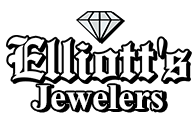
Carat, Cut, Color, and Clarity
When you’re shopping for diamonds for the special person in your life, it’s crucial to know what to look for in quality diamond jewelry. The best parameters to use would be the Four C’s: Carat, Cut, Color, and Clarity. You can prioritize one area over the rest or strive for excellence in all four categories to find the best possible stone. We’ll help you learn all about the most important aspects of your new diamond jewelry.
Carat
If you have ever shopped for diamond jewelry, you’ve likely heard the diamonds described by their carat measurement. People often conflate the term “carat” with the gold measurement “karat”. They also often assume that the carat measures the diameter of the stone, but it actually refers to its weight. Heavier diamonds will always cost more, but a careful shopper can find stones with a large diameter and great surface area while having a lesser carat weight overall depending on the way the stone is shaped and the weight is distributed. This can result in a larger looking stone for a lower cost. So when shopping for a diamond of a specific carat, make sure to look carefully for the best shape and overall surface area to suit your needs.
Cut
Finding a diamond with a high-quality cut is crucial for how your diamond will react to the light and how much sparkle it will provide. If not cut correctly, or graded as a Poor Cut by the GIA, the light entering the diamond can exit through the sides or bottom in a dull, unremarkable fashion that will drive the value of your diamond down. You should aim for diamonds graded Good, Very Good, or Excellent Cut by the GIA. The higher the quality of the cut, the higher the value your stone will have in the future and the more brilliant and sparkling it will be. The cut is one of the most important aspects of the diamond’s final appearance.
Color
When you’re shopping for a white diamond, it is in your best interest to find the lightest, clearest stone possible to reflect the light around it rather than being clouded by impurities. Slightly yellowed or murky stones will not retain value. There is a market for intentionally colorful stones such as vibrant yellow, pink, and blue diamonds, which are often highly priced and coveted, but those are for more specific pieces. Unless you really want a bright yellow diamond for a hefty cost, go for the clearest stone possible. The GIA ranks “white” diamond by color from colorless “D” grade diamonds to “Z” diamonds with visible undesirable color. The closer to “D” you get, the more valuable the stone will be in the future.
Clarity
When you hear diamonds described in conversation, clarity is one of the most important aspects to most people. Imperfections appear in almost every diamond from the natural heating and compression process that forms them. These marks are called “inclusions” and are the basis of how the GIA grades the clarity of each diamond. They range from Included, which means there are visible markings and imperfections, to Slightly, Very Slightly, and Very Very Slightly Included grades with multiple tiers in each grade. The highest graded diamonds are Internally Flawless and Flawless, which account for a tiny fraction of all diamonds in the world and barely exist in the consumer market, so VVS should be the realistic gold standard. The higher the grade, the happier you will be every time you look at that dazzling diamond.
There is a lot to consider when picking out a diamond, but with the Four C’s and the expert team at Elliott’s Jewelers, your shopping experience will be easy and enjoyable. Contact us today with any questions and we’ll help you find the perfect fit.
Content Sourced From Wikipedia
